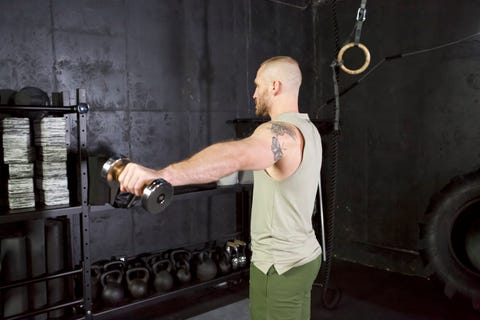On more than one occasion, a lot of us have probably wrapped up a grueling shoulder workout with a few sets of lateral raises. But there’s another underrated exercise that you should consider the next time you want to develop your delts: the Poliquin raise.
This variation, created by the late muscle scientist Charles Poliquin, not only allows you to use heavier weight than you would with a lateral raise, it also makes the weight you’re using feel even heavier, providing a new type of shoulder challenge.
The key, according to Men’s Health fitness director Ebenezer Samuel, C.S.C.S. and fitness editor Brett Williams, NASM, is to pay attention to the finer points of the exercise.
How to Do the Poliquin Raise
Lateral raises have long been a shoulder-shaping gold standard that work to pack on size to your delts. Performing the exercise is relatively routine: Raise your arms out in your scapular plane, hold for a brief pause, the lower back down with control.
The twist with the Poliquin raise, according to Samuel, is adding more time under tension while also focusing on the eccentric portion (or lowering the weight) and fighting the resistance from gravity.
“That’s the challenge of the Poliquin raise,” Samuel says. “And by doing that, we’re going to get to move even heavier weights than normal.” Setting up the Poliquin raise starts with a 90-degree angle at the elbow or arms in neutral. “Instantly, what we’ve done is we have cut our shoulder levers,” Samuel continues, “which places a lot less stress and tension on the shoulders.”
From there, raise the weights with your elbows close together. The challenge of this move soon follows, as once you get close to where you would normally raise you arms for a lateral raise, straighten your elbows—now the lever has become much longer. Then, lower for three to four seconds in a slow, controlled manner.
“The key benefit of the Poliquin raise is getting that nice control lower and taking our time to lower the weight,” Samuel says.
Since the Poliquin raise won’t be the heaviest exercise in your shoulder workout, it’s good to fit the exercise in toward the end of your routine, if not the final exercise to finish. Three sets of six to eight reps work best, just focus on keeping that time under tension for three to four seconds, which could be up to 30 additional seconds of work per set.
“You’ve hit your heavy shoulder presses, you’ve done some lateral raises, maybe you’ve done some windmills, by now your shoulders are tired,” Samuel says. “This move allows to get in few extra of eccentric contractions at the end of your set.
Want to master even more moves? Check out our entire Form Check series.
This content is created and maintained by a third party, and imported onto this page to help users provide their email addresses. You may be able to find more information about this and similar content at piano.io




Comments are closed.